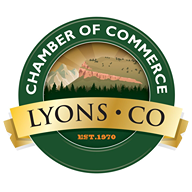A LITTLE ABOUT LYONS
In the shadow of Longs Peak all nestled in "as snug as a bug in a rug", lies the town of Lyons, Colorado. It is the town below the cliff. "The Double Gateway to the Rockies". the land of the Lyons sandstone, truly in "Red Rimrock Country".
At an elevation of 5,374 feet, about 2,000 people call it home.
“Lyons, Colorado. A small mining town with a Bluegrass problem. ”
The Lyons Area Chamber of Commerce welcomes you to our amazing town. Nestled in the foothills of northern Colorado, Lyons is known as the Double Gateway to the Rockies thanks to our unique location and natural beauty. When you come to Lyons as a visitor or as a new resident, you’ll quickly fall in love with our restaurants, shops, festivals, and beautiful parks. We may be a bit biased, but we think that you’ll find treasures in our little town that you won’t find anywhere else in the world. From tubing and whitewater kayaking right in the middle of town in the beautiful St. Vrain river, to world-class hiking, biking, and fishing, to old-fashioned community events, intimate summer concerts in Sandstone Park, and internationally-renowned music festivals at Planet Bluegrass - it’s all here in Lyons.
While we are a small mountain town, our business community is vibrant and growing. Our businesses work together to build and sustain a strong local economy. We take pride in our home- grown coffee shops, the delicious and organic food in our small grocery markets, our artist and music studios, antique stores, gift shops, casual and fine dining, top-ranked schools, our quaint museum, and more. Walk along Main Street, High Street, and Broadway to explore what Lyons has to offer - you may end up full of great food, drink, and collectibles, but we promise you won’t be disappointed.
We are so fortunate to live in this little intersection of mountain and river paradise, but sometimes... living in paradise has its costs. Lyons discovered this in September, 2013 as our beautiful St. Vrain river swelled and flooded our town. We watched as the river washed through whole neighborhoods, destroyed our roads and infrastructure, and created “islands” within our town. Most of us sadly evacuated for several months as the town government, FEMA, the National Guard, and our utility partners worked feverishly to rebuild enough for us to come home. Recovering from a natural disaster takes time, hard work, money, and most importantly, resiliency. We may have become overly familiar with shovels and sand bags, but around here, we say “Lyons, Co. We’ve Got Grit!”. We are moving forward enthusiastically as time heals the beautiful little ecosystem we call home.Visit the Redstone Museum to learn more about the history of Lyons, and our recent historic flood.
On behalf of the Lyons Area Chamber of Commerce and our members, we welcome you to our special town as a daytripper, wedding guest, festivarian, or new neighbor.
A brief history
Native Americans
The early history of Lyons tells us that Native Americans were the first settlers. Different tribes wandered in and out of the valley. Shoshones, Pawnees, Cheyenne's and the Crow Indians hunted through the area, but the Ute and Arapaho tribes lived here.
White Settlers
As early as 1861, the first white settler came to stay, and others soon followed. Some were disappointed gold seekers and others came to better their health in good old Colorado sunshine.
The United States government had the boundary line to range 71 surveyed in 1870, and range 72 was surveyed in 1874. E.S. Lyon and his wife, Adeline, came to this area in 1880, from Putnam, Connecticut, following the advice of Mr. Lyon's doctor. In 1882, the town was platted and named after E.S. Lyon, and became incorporated in 1891. It didn't take long to discover the potential of the sandstone, and soon quarries were a booming business.
Railroad
In 1884, the Denver, Utah and Pacific Railroad built a narrow gauge track into Lyons, to ship the sandstone as far east as Chicago and New York. The sandstone shipments were used on their brownstone houses. Sandstone was also used as rubble for railroad ballast, flagstone for sidewalks, and curbs and gutters. Many of the beautiful buildings on the Colorado University at Boulder campus are built with Lyons sandstone, as well as many other buildings around the country.
Over the hogback to the east of Lyons, more quarries developed, to eventually be known as Beach Hill and Noland. The town of Noland had a history all its own, until concrete hit the scene. Today, very little remains of this one-time-jumping community. But in its heyday, it was serviced by the Lyons Tower Stone Railroad, Stone Mountain Railroad, Noland Land, and Transfer railroad – all the same railroad.
The Union Pacific built the wide gauge railroad into Lyons. The Burlington and Missouri, the Chicago, Burlington and Quincy and the Burlington Railroads have served the Lyons area. At one time, Lyons was an important railhead, for not only shipping sandstone, but also for shipping gold ore. The Smuggler and Golden Age Mines up the South St. Vrain canyon were successful producers of their day.
Martin Marietta Cement Western Division
The largest industry in the area is the Martin Marietta Cement Western Division (now CEMEX), just east of Lyons. Cattle raising and farming remain prevalent in the area, as well.
Lyons claims the title of "The Double Gateway to the Rockies," as it is the junction of the North St. Vrain Highway 36-66 and the South St. Vrain Highway 7 – both of which lead to Estes Park. The highways are named after the rivers that created the canyons: Ceran St. Vrain, an early day trader.
Businesses
Many businesses continue to thrive in the area. Today, Lyons is noted for its antique shops that draw people from miles away, to collect a part of the past.


